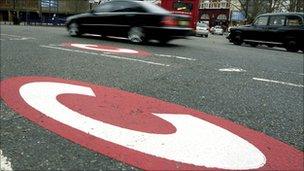Scrapping the Western Congestion Zone: What do the statistics mean?
- Published
- comments

Is a 8% increase of traffic within the former western congestion charge zone significant?
A lot of statistics are being put out at the moment by Transport for London and, as we all know, statistics can be presented in a particular way and to support a particular argument.
Take the results TfL have published about the removal of the Western Extension of the Congestion Charging Zone (WECC).
Transport for London have looked at the first 12 weeks of data from the start of the year.
Traffic entering the former zone has increased by 8%
Traffic within the zone is up by 6%
Average speed is down by 3%
There has been no impact on air quality
Some will say that an 8% traffic increase in one area is significant, particularly as the measurement period was straight after the scrapping of the scheme.
Perhaps some drivers hadn't changed their routes and didn't realise they no longer had to pay.
But Transport for London, external insist:
"That figure is at the lower end of TfL's forecast increase of 8 to 15 per cent and means that, to date, there has been less pressure on the road network than was expected."
The Mayor Boris Johnson goes further: "I am glad I gave the people a say and thrilled that the initial results suggest there has been no significant downside in removing the Western Extension zone."
The WECC was very unpopular with residents and businesses but it clearly did keep traffic levels down.
The bottom line for drivers in that area is that it now takes longer to drive somewhere and there's nearly 10% more traffic.
Probably not a surprise?
- Published3 June 2011